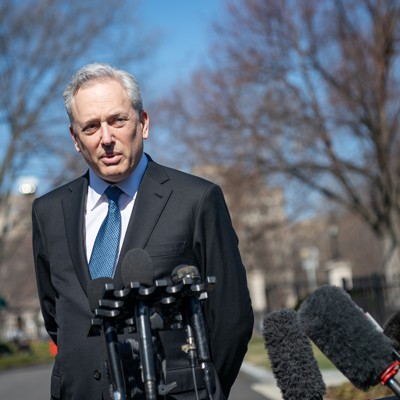White House Artificial Intelligence and Cryptocurrency Czar David Sacks said industry-friendly regulatory policies and global tech diffusion will keep the U.S. in the lead when it comes to the development of AI.
Sacks — who spoke at the AWS Summit in Washington, D.C., on Tuesday — highlighted President Donald Trump’s “pro-growth” stance and his administration’s prioritization of advancing U.S. technology globally. He singled out China as the primary adversary of the U.S., and noted that some export controls will be necessary for national security. Sacks stressed, however, that policy needs to simultaneously support the global proliferation of American AI technologies.
“We don’t want our advanced semiconductors going to our global adversaries, but we also have to care about market share,” he said. “We want the American technology stack to be broadly adopted.”
Threading this needle will take multiple policy approaches, including solidifying partnerships with ally nations to adopt U.S. AI systems, avoiding the implementation of harsh regulatory policies that could stifle innovation and building the infrastructure necessary to offer more domestic computing power.
“Let’s generate more power,” Sacks said. “Let’s get the red tape out of the way. Let’s cut 10 times more regulations than new ones we put in place.”
Among the types of regulations Sacks said should not make the cut, he singled out the controversial Biden-era diffusion rule that imposed more rigid export controls on U.S. technology and was rescinded in May.
“Diffusion … is how technology companies win,” he said. “I think that we have to have a mentality of: ‘biggest ecosystem wins.’”
Leaders from Silicon Valley previously voiced support for policies that not only favor innovation writ large, but that keep U.S. technology competitive globally. OpenAI’s Sam Altman and AMD’s Lisa Su agreed during a May Senate hearing that having American tech products at each layer of AI — from the chip level to the consumer-facing software — is critical for both national and economic security.
For the U.S., this ecosystem will be fostered in the private sector. A Silicon Valley-veteran, Sacks said the federal government needs to be an “enabler” of research and development within industry, in conjunction with friendly regulatory policy and more data center and energy resources.
“It is a race,” he said. “It’s a race to build out infrastructure. It’s a race to build out applications. It’s a race to proliferate those applications, it’s a race to get users. And we want to win that race. We want to get our companies to win that race.”
In terms of what direction the private sector is angling to take its AI tools, Sacks said he is seeing a shifting focus from generative chatbots to highly-specific AI agents.
“The big thing happening right now is we’re moving from models that are essentially chatbots to agents that can take actions on the user’s behalf,” Sacks said. “I think what we’ll see over the next six months to a year is the liberation of these digital agents that are kind of like additional personal assistants and complete tasks at the user’s direction, and those agents are connected to all your software, to all your other programs, and that’s a big change.”
He added that Trump’s recent efforts to bring AI curricula into the U.S. education system aims to assuage fears of mass worker displacement due to AI tools, referencing how the Industrial Revolution represented a comparable economic shift.
“I think that’ll be the pattern this time as well … there’ll be job displacement as workers become more productive, they’ll be able to use these tools to generate more output,” Sacks said. “I think that [it’s] actually very hard to replace a human job entirely.”


